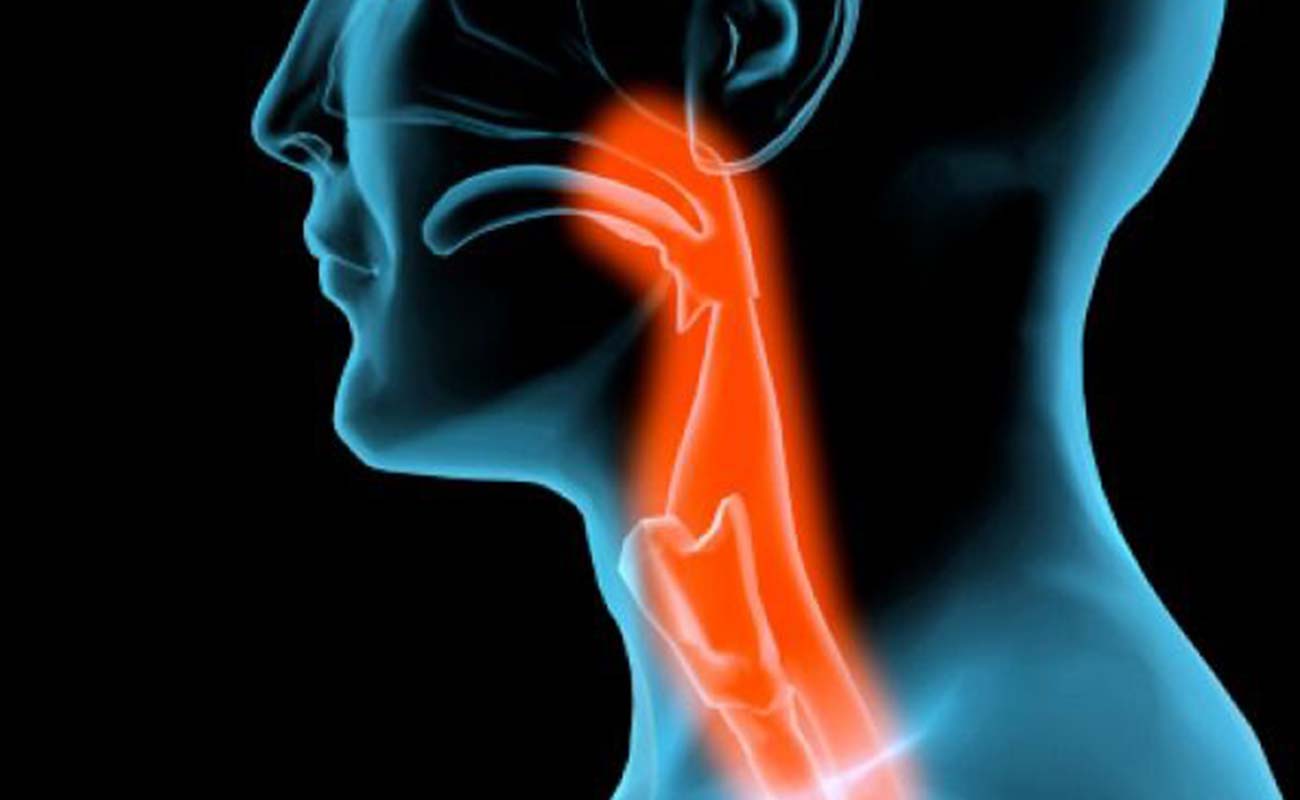Throat cancer is a general term that usually refers to cancer of the pharynx and/or larynx. Regions included when considering throat cancer include the nasopharynx, oropharynx, hypopharynx, glottis, supraglottis and subglottis; about half of throat cancers develop in the larynx and the other half in the pharynx. Consequently, any cancers (growth and/or spread of abnormal cells that form tumors or metastasize) that develop in these regions of the throat are considered throat cancers. For this article, the terms throat cancer and larynx cancer will be interchangeable. The term laryngeal cancer is also used to refer to larynx cancer.

Some investigators consider throat cancers a subset of esophageal cancers. For this article, only throat cancers will be discussed. Esophageal cancers include additional potential symptoms of burning or pain (pressure) in the throat and/or chest pain since they can extend from just below the pharynx to the junction of the esophagus and stomach. Moreover, esophageal cancers may include all of the throat cancer signs, symptoms, and most diagnostic and treatment protocols discussed in this article -- particularly when they are located high in the esophagus.

Many of these symptoms are more likely to be caused by conditions other than laryngeal or hypopharyngeal cancer. Still, if you have any of these symptoms, it is very important to have them checked by a doctor so that the cause can be found and treated, if needed.
The exact cause of laryngeal cancer isn’t known, but certain risk factors can affect the chances of developing it.
Having a risk factor for cancer doesn’t mean you’ll definitely get it. Some people with risk factors never develop cancer, and other people without any known risk factors can still develop it.
This type of cancer is rare in people under 40. It’s more common in people in their 60s and 70s. It’s five times more common in men than in women.
Smoking
The longer a person smokes for and the more they smoke, the greater the risk of developing laryngeal cancer. You might find it helpful to see our information about giving up smoking.
Alcohol
Drinking a lot of alcohol, especially spirits, over a long period of time increases a person’s risk of getting laryngeal cancer. The risk is much higher for people who are both smokers and heavy drinkers.
Human papilloma virus (HPV) infection
This is a common virus, but certain types of the virus are linked with some cancers. It can affect the moist linings in the body, including those in the throat.
We have more information about HPV and cancer.
Diet
Having a diet that’s high in animal fats and low in fresh fruit and vegetables may increase the risk of developing laryngeal cancer.
Family history
People who have a close relative (a parent, brother, sister or child) with cancer of the larynx have a slightly higher risk of developing it.
Acid reflux
Stomach acid can sometimes come back up the gullet (oesophagus) and irritate or damage the gullet lining.
This may also affect the larynx and increase the risk of cancer. It can occur when people have conditions such as gastro-oesophageal reflux disease (GORD).
As with other cancers, cancer of the larynx isn’t infectious and can’t be passed on to other people.
If you have symptoms of laryngeal cancer, such as a hoarse voice and pain when swallowing, your GP will ask about your symptoms and recent medical history.
They may also examine the inside and outside of your throat for abnormalities, such as lumps and swellings.
If laryngeal cancer is suspected, you'll probably be referred to the ear, nose and throat (ENT) department of your local hospital for further testing.
The National Institute for Health and Care Excellence (NICE) recommends that anyone aged 45 or over with persistent unexplained hoarseness or an unexplained lump in their neck should have an appointment with a specialist within two weeks.
The main tests that may be carried out in hospital are described below.
A nasendoscopy is a procedure used to get a clear view of your larynx.
During the procedure, a small, flexible tube with a light and video camera at one end (endoscope) is inserted into one of your nostrils and passed down the back of your throat. The images from the endoscope are displayed on a monitor.
You'll usually be awake while this is carried out and it may feel uncomfortable. A local anaesthetic spray is sometimes used to numb your nose and throat beforehand, so you don't feel any pain.
If it wasn't possible to get a good view of your larynx during a nasendoscopy, or a possible problem is spotted, you may have a further test called a laryngoscopy.
Like a nasendoscopy, this procedure involves using an endoscope to examine your larynx. However, the endoscope used during a laryngoscopy is longer and inserted through the mouth. This allows the larynx to be seen in greater detail.
A laryngoscopy can be very uncomfortable, so it's usually carried out under general anaesthetic (where you're asleep). You should be able to leave hospital as soon as you've recovered from the effects of anaesthetic, which is usually the same day or the day after.
During a nasendoscopy or laryngoscopy, your doctor may use small instruments to remove a sample of cells from your larynx so it can be examined for signs of cancer. This is known as a biopsy.
Alternatively, if you have a lump in your neck, a needle and syringe can be used to remove a tissue sample. This is known as fine needle aspiration.
If the results of the biopsy show you have cancer and there's a risk it may have spread, you'll probably be referred for further testing to assess how widespread the cancer is. The tests may include:
After these tests have been completed, your doctor should be able to tell you the extent of the cancer. This is known as the stage and grade of the cancer.
Healthcare professionals use a system called the TNM system to stage laryngeal cancer. T describes the size of the tumour, N describes whether cancer has spread to the lymph nodes and M gives an indication of whether the cancer has spread to other parts of the body.
There are also three different grades (1-3) used to describe laryngeal cancer. Lower-grade cancers, such as grade 1, tend to grow more slowly and are less likely to spread. Higher-grade cancers, such as grade 3, grow quickly and are more likely to spread.
The treatment for laryngeal cancer largely depends on the size of the cancer. The main treatments are radiotherapy, surgery and chemotherapy.
Most hospitals use multidisciplinary teams (MDTs) of specialists that work together to decide the best way to proceed with your treatment.
Members of your MDT will probably include a surgeon, a clinical oncologist (a specialist in non-surgical treatment of cancer), and a specialist cancer nurse who will be responsible for co-ordinating your care.
Your cancer team will recommend what they think is the best treatment option, but the final decision will be yours.
Before visiting hospital to discuss your treatment options, you may find it useful to write a list of questions you'd like to ask your care team. For example, you may want to find out the advantages and disadvantages of particular treatments.
Your recommended treatment plan will depend on the stage of the cancer (see diagnosing laryngeal cancer for more information on staging).
If you have early-stage laryngeal cancer, it may be possible to remove the cancer using surgery (endoscopic resection) or radiotherapy alone. This may also be the case with slightly larger cancers, although a combination of surgery and radiotherapy is sometimes required.
In later-stage laryngeal cancer, more extensive surgery may be needed. Radiotherapy and chemotherapy will probably be used in combination. In some cases, the entire larynx may have to be removed.
A medication called cetuximab may be used in cases where chemotherapy is not suitable.
These treatments are described below.
Radiotherapy uses controlled doses of high-energy radiation to destroy cancerous cells. It can be used as a treatment on its own for early-stage laryngeal cancer, or it can be used after surgery to stop cancerous cells returning. It's sometimes combined with chemotherapy.
The energy beams used during radiotherapy have to be precisely targeted to your larynx. To ensure the beams are directed at the exact area, a special plastic mask will be made to hold your head in the right position. A mould of your face will be taken, so that the mask can be made before treatment starts.
Radiotherapy is usually given in short daily sessions from Monday to Friday, with a break from treatment at the weekend. The course of treatment usually lasts for three to seven weeks.
As well as killing cancerous cells, radiotherapy can affect healthy tissue and has a number of side effects, including:
Your MDT will monitor any side effects and treat them when possible. For example, protective gels can be used to treat mouth ulcers, and medicines are available for a dry mouth.
Radiotherapy can sometimes cause your throat tissue to become inflamed. Severe inflammation can cause breathing difficulties. Contact your key worker or visit your local accident and emergency (A&E) department as soon as possible if you have difficulty breathing.
Most side effects should pass within a few weeks of treatment finishing.
Read more about radiotherapy.
There are three types of surgery that can be used to treat laryngeal cancer. They are:
These are described below.
Endoscopic resection can be used in early-stage laryngeal cancer.
During the procedure, a surgeon uses a special microscope to get a magnified view of the larynx. This allows them to remove the cancer either with a laser or small surgical instruments.
An endoscopic resection is carried out under general anaesthetic, so you will be unconscious during the procedure and won't feel any pain.
Your mouth and throat may feel sore for a few weeks after the operation and there's a risk of your voice changing as a result of the procedure, which can be permanent.
A partial laryngectomy can be used to treat some laryngeal cancers. The operation involves surgically removing the affected part of your larynx. Some of your vocal cords will be left in place, so you will still be able to talk, but your voice may be quite hoarse or weak.
While your larynx is healing, you may find breathing difficult. Your surgeon may need to create a temporary hole in your neck, which will be attached to a tube you can breathe through. This is known as a temporary tracheostomy.
Once your larynx has healed, the tube can be removed and the hole will heal, leaving a small scar.
This operation is uncommon nowadays, as endoscopic resection is preferred whenever possible.
A total laryngectomy is usually used to treat advanced laryngeal cancer. The operation involves removing your entire larynx. Nearby lymph nodes (small glands that form part of the immune system) may also need to be removed if the cancer has spread to them.
As your vocal cords will be removed, you won't be able to speak in the usual way after the operation. However, there are several ways to help restore your speech.
If you have a total laryngectomy, your surgeon will also need to create a permanent hole in your neck (called a stoma) to help you breath after the operation.
You will be given training on how to keep your stoma clean. Having a stoma can seem daunting and frightening at first, but most people get used to it after a few months.
Chemotherapy uses powerful cancer-killing medicines to damage the DNA of the cancerous cells and stop them reproducing. It may be used to shrink a tumor before surgery or radiotherapy, or in combination with radiotherapy to make the radiotherapy more effective.
It can also be used to treat laryngeal cancer that's advanced or has come back after treatment. In this situation, it can relieve symptoms and may slow the cancer's growth.
Chemotherapy medication is usually given as an injection into a vein (intravenously) once every three or four weeks, for up to six months. You may need to stay in hospital for a few days during each treatment or you may just come in for a short visit each time.
Chemotherapy can sometimes damage healthy tissue as well as the cancerous tissue. This, unfortunately, means side effects are common, such as:
Chemotherapy can also weaken your immune system, making you more vulnerable to infection and illness.
It's therefore important to report any symptoms of a potential infection to your MDT, such as a high temperature, chills or a persistent cough. You should also avoid close contact with people known to have an infection.
Cetuximab is a type of medication called a biological therapy. These medications target and disrupt the processes that cancerous cells use to grow and reproduce.
Cetuximab can be used in combination with radiotherapy to treat more advanced laryngeal cancer, when it's not possible to use chemotherapy. For example, people with kidney or heart disease, or people with an ongoing infection, may not be able to have chemotherapy, because it could make them very ill.
Cetuximab is given slowly through a drip into your vein (intravenously) for up to an hour or more. It's usually given weekly for up to seven weeks.
Side effects of cetuximab are usually mild and include:
Cetuximab can also trigger allergic reactions in some people, which can cause problems such as a swollen tongue or throat. In a few cases, the reaction can be severe and potentially life-threatening.
Most serious reactions occur within a day of treatment starting, so you'll be closely monitored once your treatment begins. If you have symptoms of a severe reaction, such as a rapid heartbeat or breathing problems, medication can be used to relieve them (such as corticosteroids).
Sources: nhs.uk, medscape, macmillan.org.uk, medicinenet, cancer.org
Submit Comment